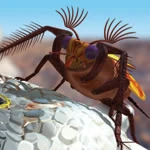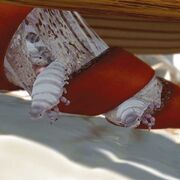
The bumblebeetle settles on a dead ocean flish, ready to spread its larvae into the nutritious mass. However, this particular flish has already been claimed, so this bumblebeetle will have to continue searching.
The bumblebeetle is a large beetle with a peculiar lifecycle that inhabits the southeastern Rainshadow Desert of Novopangea, 200 million AD, in the documentary The Future is Wild.
Low over the scrub of the Rainshadow Desert, the bulbous shape of this insect can be seen on flashing winds, roughly the size of a sparrow. No sooner does one appear than it vanishes again. Its swift passage can leave a flicker of disturbance in the sparse desert grass, and a thrumming sound hanging in the air.
The teardrop shape of its body causes little air resistance as it skims along at 8 miles (13 kilometers) per hour, dipping over sand dunes and weaving in and out of the hardy vegetation, constantly navigating its way clear of obstacles. Its membranous hind wings drive it onward, while the hard forewings, called elytra, are spread out to form an aerodynamic surface. These natural airfoils provide lift, allowing the insect to cut off its power and glide from time to time. By conserving energy in this way, it can cover great distances without tiring--even though this is the only flight it will take in its life.
The stiff elytra are more than airfoils. They also act as supports for sophisticated sensory apparatus. The beetle's forelegs, coated with scent receptors, are held along the leading edge of the forewings. Additional sensors dangle from the tail. Indeed, every available surface of the bumblebeetle is covered in sensing setae, including its antennae. This array is necessary (though the setae on the legs are usually folded down in flight to reduce drag), as the food sources the insect is hunting are spread out across the desert.
About 40 percent of the bumblebeetle's streamlined, yet bulbous body consists of fat--a store of energy built up during its larval stage. This will fuel up to a day of continuous flying, in which time the bumblebeetle can cover some 200 miles (322 kilometers), nonstop. At some point in the journey it is likely to sense food and close in on it.
The food the insect seeks is a dead ocean flish. Large numbers of ocean flish are carried over the mountains from the Global Ocean with every hypercane. By the time their carcasses tumble into the dust of the Rainshadow Desert, they have been battered and desiccated by the ferocious winds. Here and there across the arid landscape lie 'flishwrecks'--whole flocks dropped in a small area.
A flishwreck is a valuable source of nourishment to all kinds of desert-dwelling animals. The bumblebeetle, however, has evolved to rely exclusively on this food supply. Its sensory array can detect a mass of rotting flish miles away, and each individual bumblebeetle will fight its own kind to take possession of a carcass. Only one bumblebeetle can secure each flish.
The scent of decaying ocean flish spreads downward, often close to the ground, and any insect (bumblebeetles and other species) lucky enough to detect it begins to home in. Before long, the air is full of the buzz of bumblebeetles, each seeking an unclaimed carcass. If two bumblebeetles approach an unclaimed flish, a fierce aerial skirmish breaks out. These fights are rarely fatal but the loser must relinquish the prize and find a carcass of its own. Failure to find a flish in time means death not for the bumblebeetle, but for the load that it is carrying.
When a bumblebeetle claims a flish, its quest is over and so is its life. The hard-earned food is only for its offspring. Indeed, it could not enjoy a flish supper if it wanted to, for the adult has no mouth. Its body consists of wing muscles, a fat supply, and its young. As the insect alights upon the dead flish, its abdomen collapses and it releases the larvae into their new home. Then the bumblebeetle dies.
A depositing bumblebeetle has lived for a day and fulfilled its sole purpose--to find a feeding ground for its offspring. If it does not succeed within a few hours, its fat supply runs low and it begins to digest the larvae it carries in its abdomen. Indiv

Grimworms emerge from the body of the adult bumblebeetle.
iduals are sacrificed in order to maintain the genetic line. If a single larva survives to be placed in a flish carcass, then the adult bumblebeetle has done its duty.
The larvae, called grimworms, spill out from the adult's body and burrow their way into the decomposing flish. If the adult bumblebeetle lacks mouthparts, its offspring certainly make up for it. Inside the sucking, disk-shaped mouth of the grimworm is a terrifying mill of sharp jaws, coming in two pairs (one for slicing, the other for grinding). These tear through the flesh and bones of the flish carcass and suck up its putrefying internal organs.
Narrow tunnels are bored into the flesh. These are then enlarged into chambers as the grimworms chew away at their new home. The only part of the flish left untouched is the skin. Under the desert sun it shrivels to a hard leathery case, providing an ideal shelter for the grimworms. Without it they could not survive the searing heat and scouring desert wind. Safe in their flishy capsule, they live, feed and grow.
To ensure the full exploitation of each flish body, grimworms reproduce by parthenogenesis, which means that unfertilized eggs develop directly into identical larvae.
This process continues until what remains of the flish's body has become a writhing mass of grimworms. Some of these individuals are male; others are female. As they fest, they grow. Eventually, one of the females reaches her optimum weight of around half an ounce (14 grams), enormous for an insect larva. This female grimworm remains in the flish and continues to devour it along with her smaller siblings. The males burst out, chewing through their leathery tent, and set off to find another, nearby ocean flish carcass.
In a typical flishwreck, each corpse is a short distance from the next and all are at the same state of decay. They are also all occupied by the grimworm offspring of other bumblebeetles--rarely does a dead flish remain unclaimed. Those male grimworms which survive the journey form flish to flish without dehydrating or being eaten by other desert creatures are the ones that eventually mate. They do so with a fully-grown female they find in other dead flish bodies. In this way, the species ensures that its gene pool remains as large and healthy as possible.
Because they are sexual and able to breed, grimworms can hardly be considered typical insect larvae. The larva usually does most of the eating and growing while only the adult, or imago, reproduce. Sometimes, as in the case of the Human-era mayfly, the imago phase is as short-lived as that of the bumblebeetle. Hatching, mating, egg-laying and dying all occur within a day. The lifecycle of an adult bumblebeetle is far simpler. Its sole purpose is as a transporter. In the bumblebeetle-grimworm cycle, it is the grimworm phase that breeds. Throughout evolutionary time, insects have been versatile enough to evolve lifestyles to survive the harshest conditions. The bumblebeetle is a remarkable example of such strategic evolution. It has combined several strategies and lifestyles to overcome the hostile environment in which it lives.
Once she has mated, the largest female grimworm continues to grow, consuming the last of the flish's desiccated flesh. She even eats the male grimworm after copulation. When every source of food is finally exhausted (even after devouring the other females), the remaining female grimworm pupates, forming a tough, leathery cocoon that fills the old flish skin. Inside the pupa, the larva metamorphoses into a winged adult, which eventually hatches. By the time the adult bumblebeetle emerges from her pupa, already pregnant, there will be new flishwrecks to find. She will immediately set off on her brief but wide-ranging migration, in search of a food source for the next generation.
As the bumblebeetle shows, an essential condition for life in the Rainshadow Desert is the ability to range over large areas looking for food.
To disperse its seeds, a death-bottle needs the services of the bumblebeetle.
This carnivorous flowering plant has developed a leafy flower with the shape and silvery sheen of a dead ocean flish. Enzymes in the flower can even recreate a convincing odor of rotting flesh. A passing bumblebeetle will land on an ocean flish-like flower to deposit its grimworms but, after burrowing into the leafy flower through what looks like a wound, it, like the desert hopper, finds itself in a trap. Unlike the spiny chamber that other animals like desert hoppers get caught in, however, this chamber is full of sticky seeds.
The bumblebeetle blunders around in the underground chamber until, suddenly, a spring mechanism in the plant catapults it skywards. Seed-coated but safe, it flies away, continuing its quest for a real flish carcass. As it lives out its short life, flying towards a flishwreck or fighting for possession of a dead ocean flish with another of its kind, the heavy seeds fall from the insect. From these seeds, if conditions are right, new death-bottles will grow.
The relationship between the bumblebeetle, the ocean flish and the death-bottle plant is yet another example of how, when faced with an environment as harsh as the Rainshadow Desert, organisms can adapt to make brilliant use of each other.
|
|||||||||
